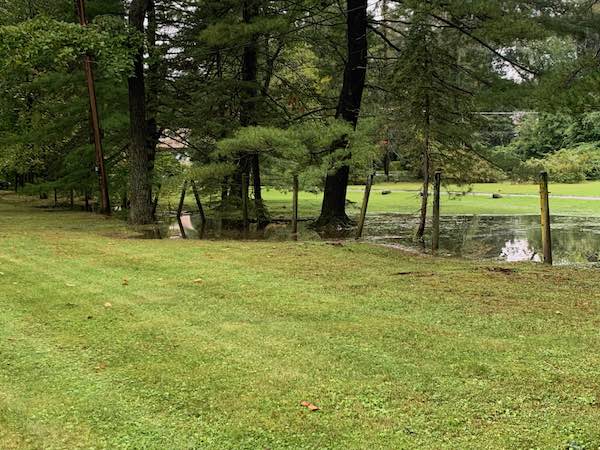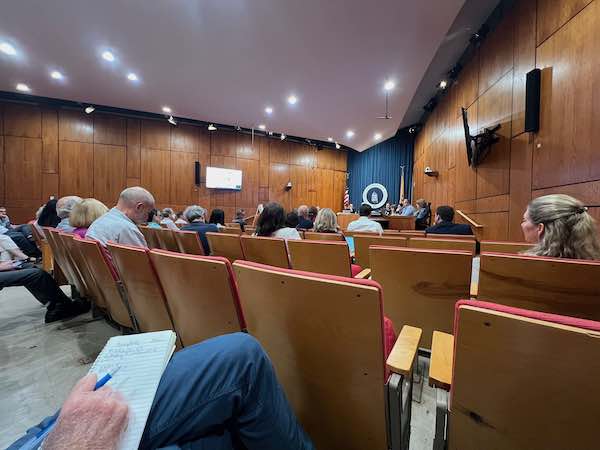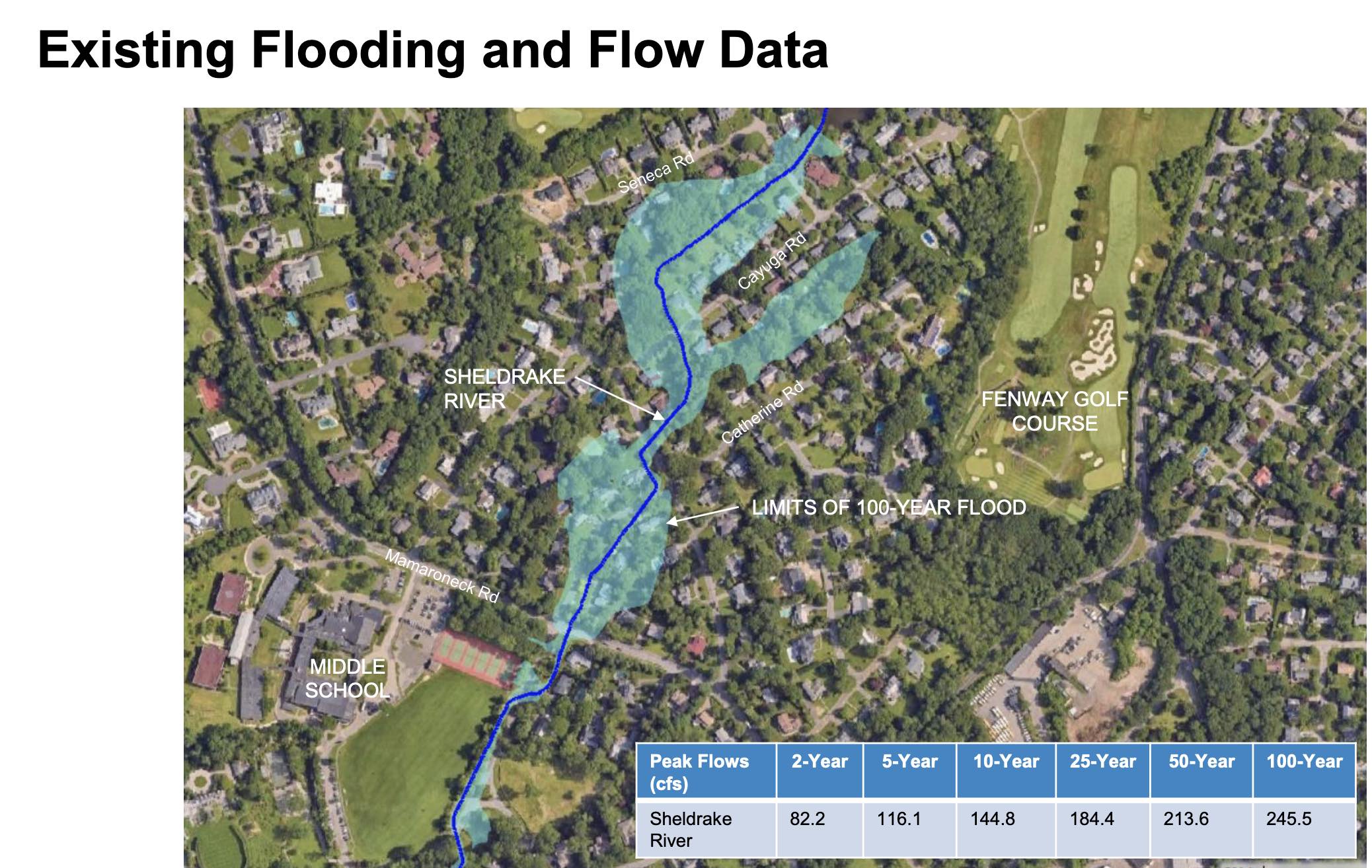Garden Road Subdivision Proposal to Undergo Environmental Review (SEQR)
- Monday, 23 September 2024 18:40
- Last Updated: Tuesday, 19 August 2025 16:10
- Published: Monday, 23 September 2024 18:40
- Joanne Wallenstein
- Hits: 2911
 According to one Cushman Road resident, “there are two kinds of people in our neighborhood. The ones who have water in their basements and the others who lie about it.” And after six years of hearings on a proposed new development in the flood-prone area, it appears that the concerns of the residents have prevailed.
According to one Cushman Road resident, “there are two kinds of people in our neighborhood. The ones who have water in their basements and the others who lie about it.” And after six years of hearings on a proposed new development in the flood-prone area, it appears that the concerns of the residents have prevailed.
On Thursday night September 19, 2024 the Scarsdale Planning Board met for a special meeting to consider an eight- home subdivision on an undeveloped lot on Garden Road in Scarsdale. Each home would have a pool and its own well, as the Village’s water system is not adequate to support these homes. The plot has a high water table and is so wet that the developer proposed to build a retaining wall and truck in an estimated 2,000 truckloads of landfill to raise the properties above the water table and permit construction of homes with full basements. Details of the plans can be viewed here.
Following testimony from the applicants, residents and two sets of attorneys representing residents, the Planning Board voted unanimously to start the process of making a Positive Declaration which would lead to a SEQR or environmental review. This is a full environmental assessment of the potential risks or the project to the residents and the Village of Scarsdale.
Remarks from the Experts
At the opening of this most recent meeting, the developer’s attorney, Lucia Chiocchio from Cuddy and Feder, explained that the developer’s plans were unchanged since the last work session in March 2024. She submitted a revised Storm Water Pollution Prevention Plan (SWPPP) and said there is a “reduction in the rate of runoff from the project site for all storm events,” and “there will be no negative impacts to neighboring properties.”
Also submitted were a “Fill Importation Plan” to ensure the quality of the fill and “a schedule and timing for fill delivery and placement on the site.”
She answered a claim from residents about the de-mapping of Woodland Road, which previously led into the property. Those who opposed the project said that the village trustees de-mapped that road in 2014 with the understanding that there would be no further development on the site. However, Chiocchio claimed, “There was no restriction in regard to development of the property.”
Since the Village passed new land use regulations, Chiocchio asked them not to make a decision that night until the applicant could update their proposal to conform to the new rules.
The applicant’s certified arborist Aaron Schmidt reviewed plans to remove 427 trees, not including any dead or fallen trees. These would be replaced with 470 new trees with a minimum caliper of 3” DBH. Schidt named a host of native trees and shrubs that would be planted.
He claimed that his analysis showed that storm water retention and transpiration would be improved by the new trees, saying when the trees were at mid-maturity, 7.4% more water would be absorbed.
Bob Starcher a geologist from Mott McDonald, the village’s consulting engineer, appeared less certain of the model calculations. He said, “There is concern from neighbors as the water table is high and building this project will exacerbate the flooding…. The question is – will the recharge from the site be greater than the current recharge on the site?”
Starcher said he reviewed the applicant’s July submission, saying, “They sent new spreadsheets but no report.”
He continued, “On September 11 we received responses. The model has come along fairly well. They understand the components of the recharge and they are trying to finish that up. If they can demonstrate that the recharge will be less then it will demonstrate there will be no adverse impacts.”
However he said, “I found an error in their calculations and that error was significantly overestimated so it made it look like the recharge was greater than it was.”
It wasn’t clear whether that error would mean more or less run off from the property.
Planning Board members asked for a definition of “recharge,” which was explained as follows:
“Recharge -water infiltrates the surface, percolates down into the water table and causes the water table to rise. Anything that gets past the plant roots and gets into the aquifer, we call that recharge as the water table will rise up in response.”
Another asked how many truckloads of land fill would be required. The response was 2,000 truckloads. They also asked if the fill would settle and how it would impact the structures.
More questions were asked about the maintenance of the water detention system. Would it be the responsibility of the homeowners?
Village Engineer Dave Goessl asked if the model provided for runoff from sump pumps or drainage systems? He said, “Where would this water go?”
Public Comment
The meeting drew residents from both the immediate area on Garden and Cushman Roads as well as those who live downstream on Cayuga and Seneca Roads. The public was given the opportunity to comment.
Richard Cantor of 11 Innes Road spoke eloquently about climate change, extreme heat and the role of trees, He is the current Chairman of the Scarsdale Rotary Club Environment Committee, a member of the Scarsdale Forum’s Sustainability Committee.  The session drew a crowd of experts, residents from Cushman and Garden Road and those who live downstream on Cayuga and Seneca Roads.
The session drew a crowd of experts, residents from Cushman and Garden Road and those who live downstream on Cayuga and Seneca Roads.
About the project on Garden Road he said, “…there are so many things wrong with it, including the damage it will do to the soil, to water mitigation, to trees, to wildlife, and to neighboring properties that it should not even be considered at the scale it is proposed. The more we dig into the details, the more egregious it becomes.”
He continued, “We are already in a climate crisis. Extreme heat is increasing across the globe. Over 170 million Americans were under extreme heat warnings this summer with heat related deaths rising into the thousands. Increasingly violent and numerous storms have devastated communities all across the globe.
About trees he said, “every single tree a developer cuts down will contribute to the heat emergency when it arrives here, and it will also contribute to the damage and flooding caused by increasing storms.”
About the landfill he said, “This developer’s plan to truck in several feet of topsoil will result in major damage to the bottom soil layer, killing off microorganisms which play critical roles in healthy biospheres and which take several hundred years to recover. Plus, without actually thoroughly testing the proposed drainage plan under storm conditions, no one can guarantee it will work. If it does not work, the results could turn out to be catastrophic for neighboring properties.”
He concluded by saying “Metaphorically we are on the Titanic and it has already hit the iceberg. For the moment some people may still be blissfully unaware sleeping in their staterooms, but disaster is soon heading our way if we don’t realize it and take immediate action now.”
“We have duties to ourselves, duties to our neighbors, and tremendous duties to future generations to proceed as responsibly as we can, and the particular proposal for the development of 80 Garden Road which starts with the removal of 437 trees does not meet the criteria of responsible development. It should be permanently prohibited from proceeding.”
SHS Senior Chloe Ji also spoke persuasively about the environment. She was an intern for the Westchester Parks Foundation this summer and participates in research regarding the distribution of greenhouse gasses, and how they differ from region to region, and over time.
She said, “Overall, trees, especially older ones, are essential to our environment. Beyond what has already been mentioned, trees are vital to mitigating the negative effects of climate change and global warming - they take in tremendous amounts of CO2 as they grow, reducing the already extremely high amounts of greenhouse gasses in the atmosphere by as much as possible.”
“They are also essential tools to water regulation, erosion control, and stormwater management . Additionally, old trees are irreplaceable conservation resources with a wide range of key ecological, evolutionary, and cultural values.”
“Village leaders are responsible for maintaining a balance between sustainability and development: and if this project is followed through with, we are sacrificing the environment for development. Not only do those in power carry a moral responsibility to protect the people in which they represent, but also to protect the land they reside on.”
Resident Marc Carter reminded the Planning Board that, “The developer is asking the Village to rescue him from his bad decision.” He said, “2,000 dump trucks – that is nuts! The Village is under no obligation to rescue him but they have an obligation to protect the residents of the Village.”

Bob Reiffel of Cayuga Road told the Board about major flooding that has occurred at his home and in his neighborhood. He said, “In 2007, the Sheldrake River crashed through the house. Our entire neighborhood was roped off. The 750 acres are one of the most endangered neighborhoods in Scarsdale. It all drains into one pipe….In 2021, we got two and half feet of sewer water spouting out of our pipes.”
He continued, “Why is the Planning Board allowing 80 Garden to proceed? Garden Road is already a wetlands. The rainwater needs to stay on the site, get absorbed or go into a retention basins.”
He said the plan to drill individual wells hundreds of feet below the surface will make flooding worse and spoke of the additional burden to the sanitary sewer system. About the clear cutting of trees, he said, “It will take decades for the trees to grow to absorb the existing water.”
He told the Planning Board, “It is your charter is to protect the residents – not to protect the developer.”
Cathy Liu who is an engineer said, “This application is flawed as there is no minimal runoff reduction.” Furthermore she said, “We know trees cannot grow in the fill, so there needs to be a significant amount of topsoil for these trees to thrive.” In addition, she said the homes would need sump pumps and that outflow should be considered in the model, along with output from irrigation.”
Brad Schwartz of the law firm Zarin and Steinmetz brought a full consulting team. They represent resident Bob Falk who lives on Willow Lane. He showed photos of an inundation of the house and said, “There are three municipal drainpipes that converge at Falk’s property and get discharged into a small stream in Falk’s backyard. During Hurricane Ida two feet of water came down the driveway and flooded his entire first floor. There is no room for error in the SWPP…. The inputs into the model are incorrect and therefore its conclusions are inaccurate.”
He continued, “In 2013 the Planning Board approved four homes on Cushman Road. Four homes were approved because the SWPP could not support nine homes. To help prevent development of the sensitive area they de-mapped the road and preventing access to it.”
Attorney Helen Mauch said she represents 29 residents near the Garden Road project. She said, “The board does not have an obligation to approve an application or to make it work….There is an undisputed record that this is a sensitive drainage area, with critical flooding and a high water table. The Board of Trustees de-mapped Woodland Road to prevent future development of this site. There should be no expectation that the Board will reverse itself. The Board has the authority to deny the application. Deny it now or make yourself a positive lead agency.”
She said she would “submit an engineers’ report showing that unrealistic assumptions were used.” She said, “The applicant does not address regional and drainage patterns.” She questioned whether fill will have the capacity to absorb the water.” She continued, “The functioning of a complex underground system that depends on maintenance is a significant risk to the neighbors.”
Andy Rodman of Cushman Road said, “This is a haphazard affair. Please protect the old houses in our neighborhood.”
Michelle Boss of 71 Cushman Road said that the water table is only a foot or two below ground, and even the fill would not be enough to contain the homes and their basements. She told the Board, “The swale in my yard will be overwhelmed. This is all based on a model that has not been tested. No plumbers think this will work. We won’t know if this will work until it fails. And the cost will be on the neighbors not on the developer. I propose the developer indemnify all of us downstream against future damage.”
Helen Maccarino, also of Cushman Road said, “I have been trying to corral our neighbors for six years. I keep coming here in the hope that we will have a different result. Six years of this back and forth… I am tired. I am happy there is such a large turnout tonight. I have a petition with 261 names who object to over development and the flooding.”
Barry Abramson of 98 Garden Road said, “I have had water in my backyard for 26 years and it is now getting worse due to the new houses on Cushman or more intense storms. Fill is debris and trees are not going to thrive in debris. All of these assumptions about mature trees will never come to be.”
Sean Kodes of 27 Cushman Road said, “In 2019 the developer tried to regrade the land behind my house – it was not allowed in 2019. The flooding has gotten worse. Eliot Senor submitted the plans for my subdivision. How have the models lived up to what was submitted? What happens before the trees go in – how do you protect us downstream? What recourse do we have if the developer doesn’t live up to what they say they will do.?”
Following the comments, the Planning Board deliberated and took action. The voted to declare themselves as lead agency for a SEQR review and to prepare SEQR documents for consideration at their October 23, 2024 meeting to issue a Positive Declaration that the proposed development may result in one or mor significant environmental impacts.
The proposal will now have to go into a lengthy review process as mandated by state law.
The first step toward this is something called "Scoping," a process that develops a written document ("scope") which outlines the topics and analyses of potential environmental impacts. This is prepared first by the applicant and then goes to the Village staff to flesh out. This can take some time and a public hearing is required.
The next step is Part II of the SEQR (State environmental Quality Review). This process examines the environmental impact of a project and covers a multitude of areas for study. If the Planning Board finds sufficient negative impact on any of the 18 topics then they can issue a positive declaration, which means the project can be denied. The SEQR process takes months and involves a search for proof of the negative impact due to things like the destruction of flora (trees) and fauna, pollution, flooding, etc. Public hearings are required for this too.
A complete explanation of the SEQR process can be found on this NY State website:
Will the developer pivot or go through the SEQR process? That is yet to be seen.










